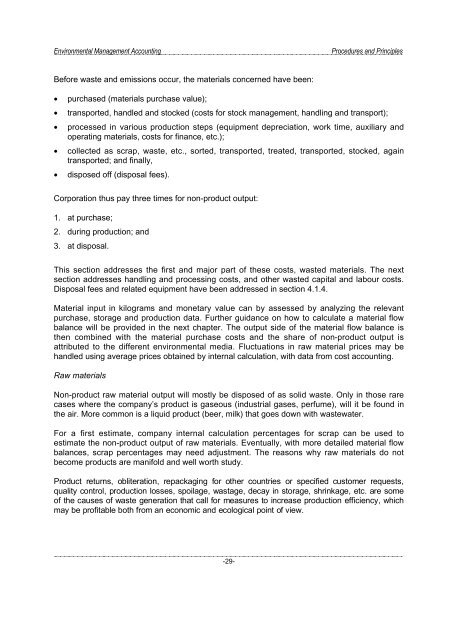Environmental Management Accounting Procedures and Principles
Environmental Management Accounting Procedures and Principles
Environmental Management Accounting Procedures and Principles
You also want an ePaper? Increase the reach of your titles
YUMPU automatically turns print PDFs into web optimized ePapers that Google loves.
<strong>Environmental</strong> <strong>Management</strong> <strong>Accounting</strong><br />
<strong>Procedures</strong> <strong>and</strong> <strong>Principles</strong><br />
Before waste <strong>and</strong> emissions occur, the materials concerned have been:<br />
• purchased (materials purchase value);<br />
• transported, h<strong>and</strong>led <strong>and</strong> stocked (costs for stock management, h<strong>and</strong>ling <strong>and</strong> transport);<br />
• processed in various production steps (equipment depreciation, work time, auxiliary <strong>and</strong><br />
operating materials, costs for finance, etc.);<br />
• collected as scrap, waste, etc., sorted, transported, treated, transported, stocked, again<br />
transported; <strong>and</strong> finally,<br />
• disposed off (disposal fees).<br />
Corporation thus pay three times for non-product output:<br />
1. at purchase;<br />
2. during production; <strong>and</strong><br />
3. at disposal.<br />
This section addresses the first <strong>and</strong> major part of these costs, wasted materials. The next<br />
section addresses h<strong>and</strong>ling <strong>and</strong> processing costs, <strong>and</strong> other wasted capital <strong>and</strong> labour costs.<br />
Disposal fees <strong>and</strong> related equipment have been addressed in section 4.1.4.<br />
Material input in kilograms <strong>and</strong> monetary value can by assessed by analyzing the relevant<br />
purchase, storage <strong>and</strong> production data. Further guidance on how to calculate a material flow<br />
balance will be provided in the next chapter. The output side of the material flow balance is<br />
then combined with the material purchase costs <strong>and</strong> the share of non-product output is<br />
attributed to the different environmental media. Fluctuations in raw material prices may be<br />
h<strong>and</strong>led using average prices obtained by internal calculation, with data from cost accounting.<br />
Raw materials<br />
Non-product raw material output will mostly be disposed of as solid waste. Only in those rare<br />
cases where the company’s product is gaseous (industrial gases, perfume), will it be found in<br />
the air. More common is a liquid product (beer, milk) that goes down with wastewater.<br />
For a first estimate, company internal calculation percentages for scrap can be used to<br />
estimate the non-product output of raw materials. Eventually, with more detailed material flow<br />
balances, scrap percentages may need adjustment. The reasons why raw materials do not<br />
become products are manifold <strong>and</strong> well worth study.<br />
Product returns, obli t er at ion, repac kagi ng for ot her countr ies or speci fi ed cus tomer reques ts ,<br />
quali ty cont r ol , pr oduct i on los s es , spoil age, was tage, dec ay in stor age, shri nk age, etc . ar e some<br />
of the c auses of was te generati on that c al l for meas ur es to incr eas e pr oduct ion eff i ci ency , whi ch<br />
may be profi t able both f r om an economic <strong>and</strong> ec ol ogi cal poi nt of v iew.<br />
-29-




